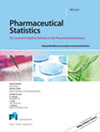Pharmaceutical Statistics is an industry-led initiative, tackling real problems in statistical applications. The Journal will publish papers which share experiences in the practical application of statistics within the pharmaceutical industry. It will cover all aspects of statistical applications in the industry from discovery, through pre-clinical development, clinical development, post-marketing surveillance, consumer health, production, epidemiology, and health economics. The Journal will be both international and multidisciplinary reflecting the nature of the pharmaceutical industry. It will include high quality practical papers, case studies and review papers. Each issue will feature a Teacher's Corner, Consultant's Forum, Reviews and Viewpoint sections. Purely theoretical papers will not be accepted. The aims of the Journal are to: Disseminate information and practical examples of the use of statistics in all stages of drug development, from discovery to production; Debate the ways in which the practice and application of statistics within the industry can best be developed; and to discuss and bring awareness to regulatory guidance documents; Draw upon and promote the full range of statistical methods and statistical thinking within the pharmaceutical industry; Provide a vehicle for communication between practitioners, researchers, educators and policy makers concerned with the application of statistics within drug development; Provide guidance and tutorials to statisticians working within the pharmaceutical industry. It is intended that both the readers and authors of the Journal include statisticians working in the pharmaceutical industry and, because of its non-theoretical nature, also non-statisticians such as clinicians, toxicologists, biologists, biochemists, chemists and genomic scientists.
